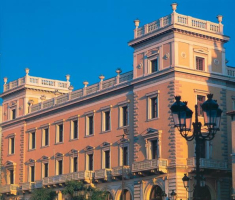Mela Building

Mela Building
Vassilis Melas commissioned the study and construction of the building to the famous German architect, Ernst Ziller, who built the largest private Athenian building of the time at a cost of 1 million drachmas.
The building carries features of the architect's style (polyhedral facade surfaces, color sculptural decoration, straight frames, slats, arched or straight angled door) - elements found in other Ziller creations, such as the Presidential Mansion, the Ilion Melathron (Heinrich Schliemann House), the National Theater and the National Archaeological Museum.
Originally the building was referred to as a luxury hotel named "Grand Hotel d 'Athènes", although we do not know if it ever really functioned. In 1881, the Athens Stock Exchange is housed on the property, while from 1888 until 1894 the Athenian Club moved there. When Melas died in 1884, the building was bequeathed by his will to the Mela Foundation that is operating until the present day. After the big fire of 1887, the building suffered serious damage and its restoration was assigned to the engineer Petros Protopapadakis, who completed it in 1889. Moreover, in 1909, based on a study by the architect Philip Oikonomou, a third floor was added. Like all the buildings in Athens, the "Mela" followed its own history in the 1940’s, when during the war the Censorship Service, the English Transmission Service, and various German military services settled there. Later, during the Civil War, it was utilized by the English Guard. Since 1900, the structure has been rented by the Hellenic Ministry of Communications and remained the headquarters of Athens' central Post Office until 1974, when the Ministry of Culture declared it a preservable site. In 1977, it was leased by the National Bank of Greece and, always in cooperation with the Mela Foundation, decides to restore the building to its original form, demolishing the third floor - based on a study by the architect Dionisis Vlachopoulos.
It is really worth devoting a little of your time to take a closer look at the building. To admire it from an architectural point of view and to see more clearly the individual points that define it. A better observation and a close approach allow spectators to see the wonderful decorative Caryatids, the beautiful arches, the turrets and the metallic circular heads of god Hermes. On the side of Aiolou Street, there is a small entrance that serves customers, since there is one of the many ATMs of the National Bank. If you take a good look through the glass door of the entrance you will see a lovely black and white marble corridor decorated with statues. Unfortunately, it is the only point from the inside that we can see, as admission is not allowed to the public. Now, if you want to capture the beauty of the building in a photo, we suggest that the best spot is located right across the "Mela", from the premises of the George Stavrou building, which also houses another part of the National Bank.








